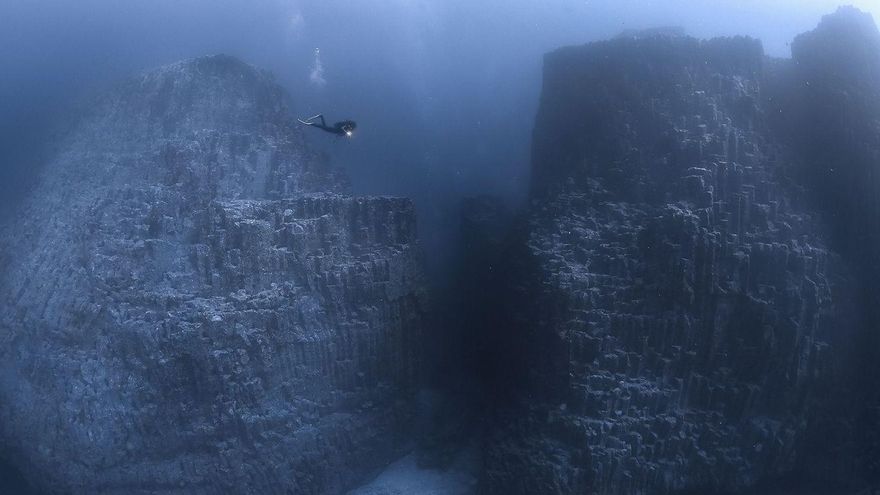
The north coast of the island of Tenerife hides an authentic natural treasure, one of the most amazing underwater landscapes on the planet, discovered just 26 years ago. On bottoms of black sand and rocks large gray stone structures emerge, almost 50 meters high, and thousands of columns knocked down by the sea and time that evoke the remains of a lost civilization and fuel the myth of Atlantis. La Rapadura is the result of a volcanic process whose age is between 500,000 and 1,000,000 years, a basaltic lava flow that reached the ocean and, as it cooled and solidified, contracted, in a process known as columnar disjunction, forming the cracks and fissures that give shape to this authentic wonder of nature.
Under the abandoned bunker of La Quinta, just over 100 meters from the coast of the Tenerife municipality of Santa Úrsula, El Piquillo can sometimes be seen, the upper part of one of the structures of La Rapadura. This tangle of blocks and columns at different levels is similar to the Giant’s Causeway in Northern Ireland. In Tenerife they rest, sometimes piled up, in a wide area at depths ranging from 15 to 50 meters.
Three nautical miles from the old dock of Puerto de la Cruz, the remains of this natural process turn a relatively barren seabed into one of the hundred best dives on the planet, according to the American magazine Sport Diver in 2018. For the photographer from Tenerife, Francis Pérez, winner of the World Press Photo 2017 in the nature category , La Rapadura is much more than that: «For me it is the most spectacular underwater landscape in the world».
Ramiro Martell, from Ecosub Tenerife, discovered El Castillo in 1996, the first known structure of La Rapadura. The whole set takes its name from a rock from the coast with a conical shape reminiscent of the sweet palmero of gofio, honey, almonds and sugar. In 2012, La Rapadura appeared on a double page in the prestigious National Geographic magazine, thanks to a photo by Francis Pérez, and became very popular among diving enthusiasts. In September 2014, while preparing a documentary on the submerged landscapes of the Canary Islands, another group of divers found Las Torres, an even larger formation, with three peaks of almost 50 meters, and a large number of landslides, near the same area. Its discoverers were Francis Pérez himself, Rafa Herrero, Joaquín Gutiérrez and Eduardo Acevedo, who spent several months photographing and recording the area without revealing the secret to anyone. That privilege was reserved for the television program Volando voy, by Jesús Calleja, which in August 2015 showed him to the world with an underwater robot.
Descending to La Rapadura is not within the reach of any diver. Despite its proximity to the coast, it is not an easy place to dive due to the strong currents and the usual waves. In order to enjoy everything that this place offers, where there is also a forest of a type of coral known as gorgonian, it is necessary to make between three and four dives.
These natural formations, also compared to the organs of old churches, are located in an environment where marine life has been affected by prohibited fishing techniques, such as the use of explosives. «Radical fishing with boreholes», already eradicated, «has greatly affected the fauna, but we believe that in the coming years it could begin to recover if this environment is left to rest. Now schools of palometas, turtles and, above all, shallow-water fish are often seen,” says Francis Pérez. In his opinion, it would be essential for these spectacular Canarian seabeds to have some type of protection “beyond the Protected Landscape of Costa Acentejo”, and he advocates that they be declared a natural monument, like Los Órganos de La Gomera (another example of columnar disjunction) , the mountain of Tindaya, in Fuerteventura, or the Roque Nublo, in Gran Canaria.
Francis Pérez never tires of diving and photographing this area of the Atlantic that “it seems to be the product of the hand of man, but it is a work of nature”. And for several years he has been working, at the request of the Santa Úrsula City Council, on the project for the creation of a museum dedicated to La Rapadura. To the thousands of photos and videos of recent years, a 360-degree recording has recently been added that will allow visitors to immerse themselves, through virtual reality, in those funds.
The councilor for the Environment of the Consistory of Santa Úrsula, Janira Gutiérrez, explains that his municipality has one million euros to rehabilitate the Casa del Capitan, a 17th-century building, and turn it into “the museum of this cathedral of the sea.” Both projects are in the drafting phase and the councilor is confident that they can be completed “before the end of the year.”
The current corporation expects to leave The tender for some works that should be completed in the next term, between 2023 and 2027, is underway. «We want this unique place to be able to get to know it in depth, without the need to dive more than 40 meters deep. Our intention is that this museum allows us to discover what La Rapadura is and how it was formed, and to contemplate it through photographs and videos. Virtual reality will also offer the opportunity to immerse yourself in our waters to enjoy something that is simply unique”, says Janira Gutiérrez.
This project will also propose the extraction, for detailed scientific study, of one of the columns of La Rapadura. The objective of this operation is to obtain data such as the date of the eruption or the exact composition of the volcanic material. This piece of laundry on which part of the municipality of Santa Úrsula is based would be one of the key pieces of the future museum.
















